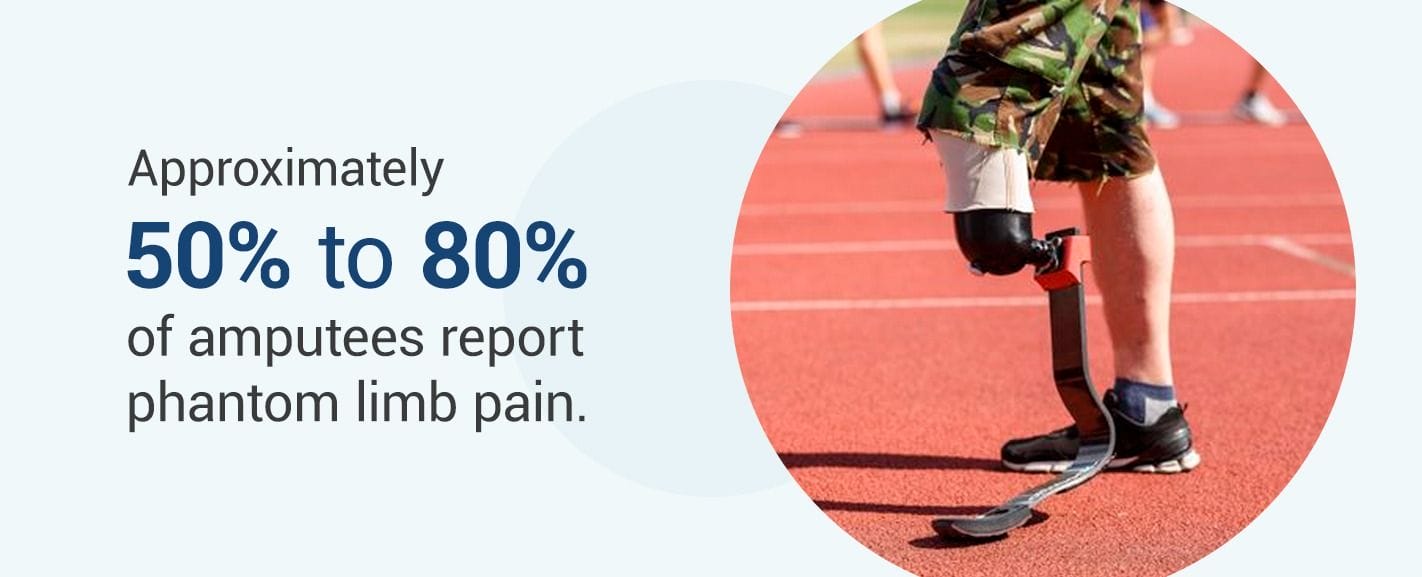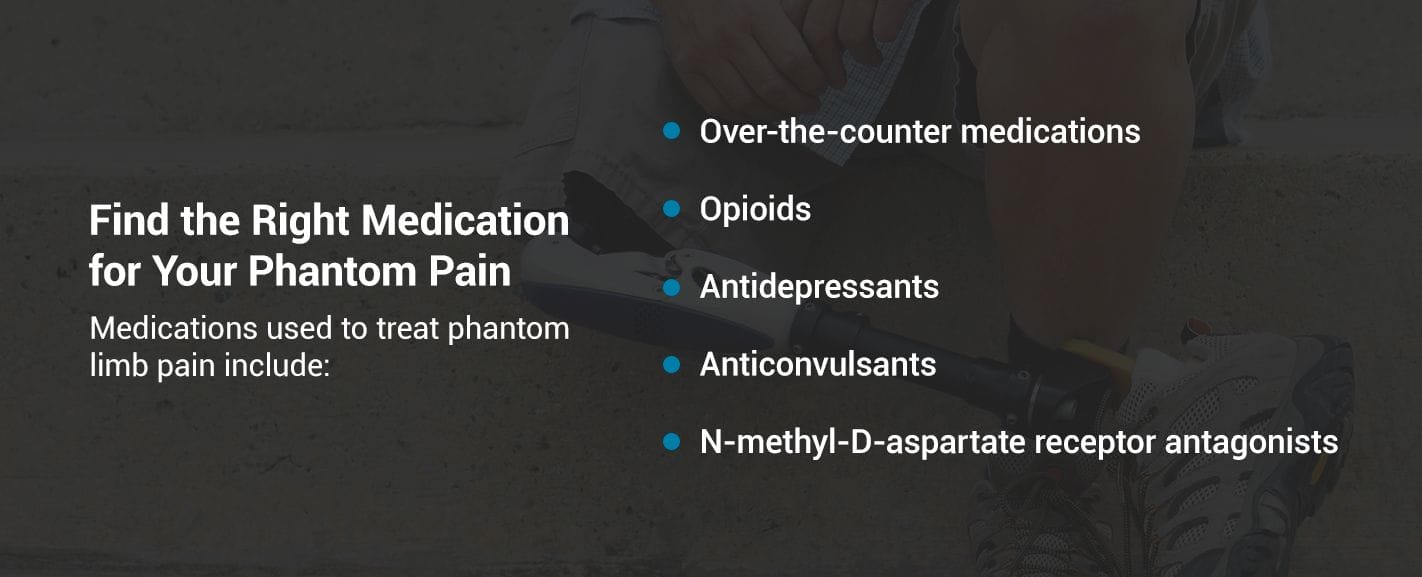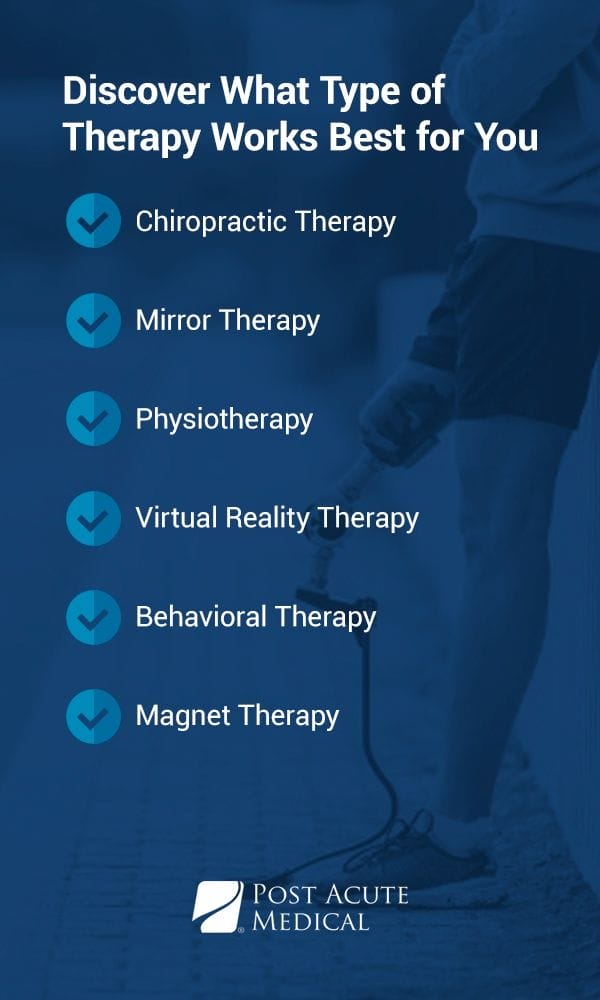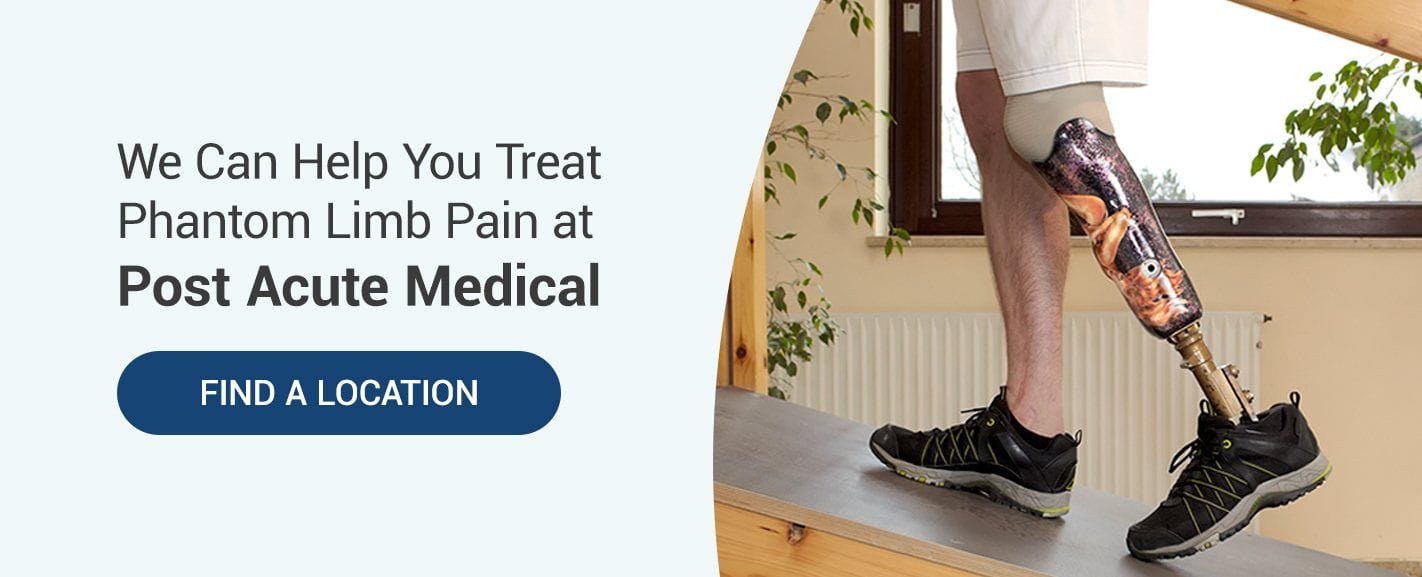
Losing a limb is a major change. Whether you have undergone amputation due to illness or trauma, it will take time to adjust to your life afterward. While navigating what changes to make in your daily routine, whether with a prosthesis or without, you may experience significant pain from the absent limb.
This pain is not imagined. Just because your limb is gone does not mean this feeling is any less real. Why do you feel this pain? Will it ever go away? How can you best treat it? Learning about phantom limb pain can help you decide what options are best for you.
View PAM Health’s Amputation Rehabilitation Programs

What Causes Phantom Pain?
How can something that is no longer attached to your body hurt? Although not everyone who has undergone an amputation will experience this issue, most do. Approximately 50% to 80% of amputees report phantom limb pain. How exactly that pain feels can differ from person to person. Some people experience a feeling best described as pins and needles. Others experience a burning or shooting pain. The sensation can come and go, or it can be constant.
The exact reason for phantom limb pain is still not understood by medical experts. Previously, it was thought to be a kind of psychological pain. The reasoning behind this idea is that the grief caused by the loss of a limb and the persistent wish that it was still there results in phantom pain.
Now, the prevailing theory has moved away from the psychological explanation to one of physiology. Scientists and medical experts believe phantom limb pain is caused by nerves in the brain and spine. Nerves in the brain and spinal cord connect to the body’s limbs. When a limb is amputated, the brain and spinal cord stop receiving input from the nerves in that appendage. As a result, the brain needs to adjust.
The Role of Nerves in Experiencing Phantom Pain
Experts believe this adjustment can result in pain in different areas. The brain could be interpreting the loss of the limb, and therefore the loss of information from those nerves, as “something wrong.” The body’s natural response to an abnormality is pain. Other research suggests that the brain does a type of rewiring.
Because the brain can no longer receive input from the missing limb, it reroutes where that input is received. If you touch another part of your body, your brain may interpret that sensory input as pain in the missing limb. Scar tissue and damaged nerves at the site of amputation may also play a role in phantom limb pain.
Whatever the cause of phantom pain, researchers have linked a couple of factors that increase the likelihood of experiencing it. If the amputated limb was painful prior to the procedure, you may be more likely to experience phantom pain later. In this case, your brain could remember the pain you felt and continue sending those signals despite the amputation. Similarly, people who experience continued pain in the part of the limb that remains are also susceptible to enduring phantom pain.
How to Manage Phantom Limb Pain
Does phantom limb pain ever go away? The answer will be different for every person. Sometimes it will improve over time or even resolve. The pain may also worsen over time or remain consistent. In many cases, phantom limb pain is a long-lasting condition. If you are experiencing phantom limb pain, treatment options are available.
Phantom limb pain treatment can come in the form of medication and different types of therapy. Management of this condition can require adequate time and different treatment combinations to find what approach works best for you.

Find the Right Medication for Your Phantom Pain
How do you treat phantom limb pain? When you experience this phenomenon, your doctor might suggest medication as a frontline treatment option. If you are considering medication, it is important to discuss your options with your doctor. They can make appropriate recommendations, explain potential side effects and provide you with a prescription. Medications used to treat phantom limb pain include:
- Over-the-counter medications. Over-the-counter painkillers, like acetaminophen or ibuprofen, are one option. If the pain you are experiencing is severe and chronic, the next step is to talk to your doctor about other options.
- Opioids. Opioids, such as morphine, are powerful prescription painkillers. These drugs are considered controlled substances. If you have a history of substance misuse, your doctor will likely explain why a prescription of opioids is not the right treatment approach.
- Antidepressants. Certain antidepressants may be prescribed to treat phantom limb pain because they can address nerve pain, also known as neuropathic pain.
- Anticonvulsants. Anticonvulsants, a type of drug commonly prescribed to treat epilepsy, can also help address nerve pain.
- N-methyl-D-aspartate receptor antagonists. N-methyl-D-aspartate receptor antagonists, such as ketamine, can block receptors and brain activity associated with pain signals.

Discover What Type of Therapy Works Best for You
Medication has the benefit of being a simple, noninvasive treatment option, but it does not always work for everyone. Ask a professional about the different types of therapy for phantom limb syndrome that have shown promise in treating this condition, including the following.
Chiropractic Therapy
Phantom limb pain therapy can take many forms. Chiropractic therapy focuses on spinal alignment. A chiropractor will work with you to relieve pain through a series of spinal manipulations. While chiropractic therapy focuses on the back and is often used to address chronic back pain, it can positively impact phantom pain.
If you lost a lower limb, you might already be at risk of experiencing back pain. Additionally, pain from the sciatic nerve, which runs from your lower back and down through your buttocks and leg, can play a role in phantom pain. This nerve can cause referred pain. You feel the ache in your amputated limb or in the part of the appendage that is no longer there, but the pain is actually caused by the sciatic nerve.
Chiropractic therapy can address that issue, reducing discomfort in the back and phantom sensations.
Mirror Therapy
You can do mirror therapy with a therapist’s help, or you can try exercises on your own. This treatment aims to convince your brain, which is responsible for the signals causing phantom pain, that both of your limbs are intact. You can perform mirror therapy by placing a mirror next to your intact arm or leg, so you can see it reflected in a natural position.
You can view your intact limb and its reflection, essentially showing your brain that no amputation has occurred. Spend 20 to 25 minutes per day looking at this image in the mirror, performing different movements with your intact limb. Studies of mirror therapy have shown promising pain resolution in amputees over time.
Physiotherapy
Physiotherapy, also called physical therapy, involves various exercises and hands-on techniques. You will work with a physiotherapist to evaluate your amputation site and create a care plan, which can involve stretching, strengthening exercises and manual massages. Physiotherapists may also recommend that you try the different types of therapy explored here.
For example, they may show you how to practice mirror therapy at home. Or, they may refer you to a chiropractor for chiropractic therapy. Physiotherapy can also help you adjust to wearing a prosthetic. This treatment type is designed to help people regain as much movement as possible and reduce pain. Some amputees have had success with this approach.
Virtual Reality Therapy
Virtual reality therapy is similar to mirror therapy in that you are shown an intact image of your amputated limb. Using virtual reality technology, typically a headset, you will see your limbs healthy and intact. While immersed in the virtual experience, you will be guided through a series of different exercises. A recent study demonstrated a notable reduction in phantom limb pain intensity. Virtual reality therapy is also used to help treat post-traumatic stress disorder, which may be something amputees also contend with during their recovery.
Behavioral Therapy
Behavioral therapy is a common treatment for mental health issues like anxiety and depression. While phantom limb pain may result from physical sensations in the body, this mind-based approach can also help manage it. Your therapist will help you identify negative thought patterns and behaviors that contribute to how you experience pain. Over time, behavioral therapy can help patients form better habits and ways of thinking that can change their reactions to phantom limb pain.
It is not uncommon for amputees to suffer from depression following the procedure. Behavioral therapy can also address this issue. Eye Movement Desensitization and Reprocessing is a type of psychotherapy most often used in treating post-traumatic stress disorder and trauma, though it has also shown success in treating amputee patients who experienced phantom limb pain.
Magnet Therapy
Phantom limb pain can be associated with decreased blood flow. While not definitively proven, magnets are thought by some to increase blood flow, therefore reducing pain. You can apply this alternative therapy in many different ways. It can be as simple as placing magnets on your limb, or it can involve equipment that generates a magnetic field.
Researchers have seen some promise in transcranial magnetic stimulation for phantom limb pain. This treatment involves placing equipment on your scalp to deliver a magnetic pulse to the brain. This can stimulate the brain and result in reduced phantom limb pain. Transcranial magnetic stimulation is also used as a treatment option for depression.
Try Other Non-Medication Treatments
If medication and various therapies have not worked for you, you can try numerous other treatments, such as the ones below.
Acupuncture
Acupuncture is a form of traditional Chinese medicine that involves inserting thin needles into various body parts. This practice is meant to balance a person’s energy. Some people who suffer from phantom limb pain have found relief through acupuncture. Acupressure is a similar approach, using manual touch instead of needles.
Transcutaneous Electrical Nerve Stimulation (TENS) Unit
Transcutaneous electrical nerve stimulation units are small, portable devices that deliver a weak electric current to your body via patches placed on your skin. The electrical current may be able to interrupt the pain signals causing your phantom limb pain. If you have lost a limb on one side of your body — for example, your left arm — the pads of the TENS unit would be placed on the intact arm in the area where you feel the most phantom pain.
If you have lost limbs on both sides of your body — such as both arms — the pads of the TENS unit will be placed on the remaining limbs to attempt to disrupt the pain signals.
Biofeedback
Biofeedback employs the body and mind to give you control over your body’s involuntary actions, such as pain. Biofeedback that focuses on muscle tension and body temperature may be helpful for people with phantom limb pain. In muscle tension biofeedback, also called electromyographic biofeedback, you learn how to both tense and relax your muscles.
Over time, this can help you manage your phantom limb pain, particularly if the type of pain you experience is cramping. Body temperature biofeedback can help you increase the blood flow — and therefore the temperature — of your limbs, which could reduce phantom pain.
Silver Shrinker Socks
Changes in the weather have been associated with increased phantom limb pain. Silver shrinker socks, designed to be worn over the residual limb, may protect against weather changes and reduce phantom limb pain. The pressure of the silver shrinker sock may also contribute to reducing pain.
Be Sure Your Prosthetic Fits Correctly
Different factors, such as your activity level and goals, go into finding the right prosthesis. But, the most important element of adjusting to a prosthesis is the fit. If the fit is not right, this can contribute to both pain in your remaining limb and phantom pain. Whether you are new to wearing a prosthesis or you have had one for a while, it is important to have a proper fit.
If you are looking for some help, Post Acute Medical can schedule you with a prosthetist for a consultation to evaluate your needs and prepare you for prosthetic use.



